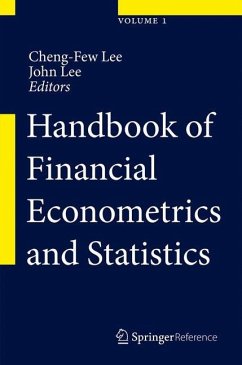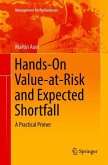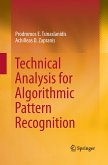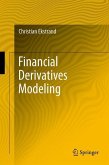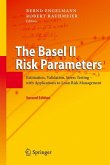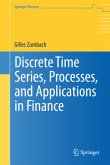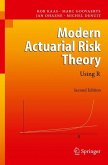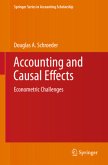Handbook of Financial Econometrics and Statistics
Herausgegeben:Lee, Cheng-Few; Lee, John C.
Handbook of Financial Econometrics and Statistics
Herausgegeben:Lee, Cheng-Few; Lee, John C.
- Gebundenes Buch
- Merkliste
- Auf die Merkliste
- Bewerten Bewerten
- Teilen
- Produkt teilen
- Produkterinnerung
- Produkterinnerung
The Handbook of Financial Econometrics and Statistics provides, in four volumes and over 100 chapters, a comprehensive overview of the primary methodologies in econometrics and statistics as applied to financial research. Including overviews of key concepts by the editors and in-depth contributions from leading scholars around the world, the Handbook is the definitive resource for both classic and cutting-edge theories, policies, and analytical techniques in the field. Volume 1 (Parts I and II) covers all of the essential theoretical and empirical approaches. Volumes 2, 3, and 4 feature…mehr
Andere Kunden interessierten sich auch für
![Hands-On Value-at-Risk and Expected Shortfall Hands-On Value-at-Risk and Expected Shortfall]() Martin AuerHands-On Value-at-Risk and Expected Shortfall43,99 €
Martin AuerHands-On Value-at-Risk and Expected Shortfall43,99 €![Technical Analysis for Algorithmic Pattern Recognition Technical Analysis for Algorithmic Pattern Recognition]() Prodromos E. TsinaslanidisTechnical Analysis for Algorithmic Pattern Recognition90,99 €
Prodromos E. TsinaslanidisTechnical Analysis for Algorithmic Pattern Recognition90,99 €![Financial Derivatives Modeling Financial Derivatives Modeling]() Christian EkstrandFinancial Derivatives Modeling38,99 €
Christian EkstrandFinancial Derivatives Modeling38,99 €![The Basel II Risk Parameters The Basel II Risk Parameters]() The Basel II Risk Parameters82,99 €
The Basel II Risk Parameters82,99 €![Discrete Time Series, Processes, and Applications in Finance Discrete Time Series, Processes, and Applications in Finance]() Gilles ZumbachDiscrete Time Series, Processes, and Applications in Finance38,99 €
Gilles ZumbachDiscrete Time Series, Processes, and Applications in Finance38,99 €![Modern Actuarial Risk Theory Modern Actuarial Risk Theory]() Rob KaasModern Actuarial Risk Theory94,79 €
Rob KaasModern Actuarial Risk Theory94,79 €![Accounting and Causal Effects Accounting and Causal Effects]() Douglas A. SchroederAccounting and Causal Effects112,99 €
Douglas A. SchroederAccounting and Causal Effects112,99 €-
-
-
The Handbook of Financial Econometrics and Statistics provides, in four volumes and over 100 chapters, a comprehensive overview of the primary methodologies in econometrics and statistics as applied to financial research. Including overviews of key concepts by the editors and in-depth contributions from leading scholars around the world, the Handbook is the definitive resource for both classic and cutting-edge theories, policies, and analytical techniques in the field. Volume 1 (Parts I and II) covers all of the essential theoretical and empirical approaches. Volumes 2, 3, and 4 feature contributed entries that showcase the application of financial econometrics and statistics to such topics as asset pricing, investment and portfolio research, option pricing, mutual funds, and financial accounting research. Throughout, the Handbook offers illustrative case examples and applications, worked equations, and extensive references, and includes both subject and author indices.
Produktdetails
- Produktdetails
- Verlag: Springer / Springer New York / Springer, Berlin
- Artikelnr. des Verlages: 86246420, 978-1-4614-7749-5
- 2015
- Seitenzahl: 3020
- Erscheinungstermin: 28. September 2014
- Englisch
- Abmessung: 241mm x 160mm x 183mm
- Gewicht: 1390g
- ISBN-13: 9781461477495
- ISBN-10: 1461477492
- Artikelnr.: 37763327
- Herstellerkennzeichnung
- Springer-Verlag GmbH
- Tiergartenstr. 17
- 69121 Heidelberg
- ProductSafety@springernature.com
- Verlag: Springer / Springer New York / Springer, Berlin
- Artikelnr. des Verlages: 86246420, 978-1-4614-7749-5
- 2015
- Seitenzahl: 3020
- Erscheinungstermin: 28. September 2014
- Englisch
- Abmessung: 241mm x 160mm x 183mm
- Gewicht: 1390g
- ISBN-13: 9781461477495
- ISBN-10: 1461477492
- Artikelnr.: 37763327
- Herstellerkennzeichnung
- Springer-Verlag GmbH
- Tiergartenstr. 17
- 69121 Heidelberg
- ProductSafety@springernature.com
Cheng-Few Lee is a Distinguished Professor of Finance at Rutgers Business School, Rutgers University and was chairperson of the Department of Finance from 1988-1995. He has also served on the faculty of the University of Illinois (IBE Professor of Finance) and the University of Georgia. He has maintained academic and consulting ties in Taiwan, Hong Kong, China and the United States for the past three decades. He has been a consultant to many prominent groups including, the American Insurance Group, the World Bank, the United Nations and The Marmon Group Inc., Wintek Corporation and Polaris Financial Group, etc. Professor Lee founded the Review of Quantitative Finance and Accounting (RQFA) in 1990 and the Review of Pacific Basin Financial Markets and Policies (RPBFMP) in 1998, and serves as managing editor for both journals. He was also a co-editor of the Financial Review (1985-1991) and the Quarterly Review of Economics and Business (1987-1989). In the past thirty-two years, Dr. Lee has written numerous textbooks ranging in subject matter from financial management to corporate finance, security analysis and portfolio management to financial analysis, planning and forecasting, and business statistics. Dr. Lee has also published more than 200 articles in more than twenty different journals in finance, accounting, economics, statistics, and management. Professor Lee has been ranked the most published finance professor worldwide during 1953-2008. Alice C. Lee is currently a Vice President in the Model Validation Group, Enterprise Risk Management, at State Street Corporation. Most recently, she was an Assistant Professor of Finance at San Francisco State University. She has over 20 years of experience and a diverse background, which includes academia, engineering, sales, and management consulting. Her primary areas of teaching and research are corporate finance and financial institutions. She is coauthor of Statistics for Business and Financial Economics, 2e (withCheng F. Lee and John C. Lee) and Financial Analysis, Planning and Forecasting, 2e (with Cheng F. Lee and John C. Lee). In addition, she has co-edited other annual publications including Advances in Investment Analysis and Portfolio Management (with Cheng F. Lee). John C. Lee is a Microsoft Certified Professional in Microsoft Visual Basic and Microsoft Excel VBA. He has a Bachelor and Masters degree in accounting from the University of Illinois at Urbana-Champaign. John has worked over 20 years in both the business and technical fields as an accountant, auditor, systems analyst and as a business software developer. He is the author of the book on how to use MINITAB and Microsoft Excel to do statistical analysis which is a companion text to Statistics of Business and Financial Economics, of which he is one of the co-authors. In addition, he also published Financial Analysis, Planning and Forecasting, 2e (with Cheng F. Lee and Alice C. Lee). John has been a Senior Technology Officerat the Chase Manhattan Bank and Assistant Vice President at Merrill Lynch. Currently, he is the Director of the Center for PBBEF Research.
Introduction to Financial Econometrics and Statistics.- Experience, Information Asymmetry, and Rational Forecast Bias.- An Overview of Modeling Dimensions for Performance Appraisal of Global Mutual Funds.- Simulation as a Research Tool for Market Architects.- Motivations for Issuing Putable Debt: An Empirical Analysis.- Multi Risk-Premia Model of U.S. Bank Returns: An Integration of CAPM and APT.- Non-Parametric Bounds for European Option Prices.- Can Time-Varying Copulas Improve Mean-Variance Portfolio?- Determinations of Corporate Earnings Forecast Accuracy: Taiwan Market Experience.- Market-Based Accounting Research (MBAR) Models: A Test of ARIMAX Modeling.- An Assessment of Copula Functions Approach in Conjunction with Factor Model in Portfolio Credit Risk Management.- Assessing Importance of Time-Series versus Cross-Sectional Changes in Panel Data: A Study of International Variations in Ex-Ante Equity Premia and Financial Architecture.- Does Banking Capital Reduce Risk?: An Application of Stochastic Frontier Analysis and GMM Approach.- Evaluating Long-Horizon Event Study Methodology.- Effect of Unexpected Volatility Shocks on Intertemporal Risk-Return Relation.- Combinatorial Methods for Constructing Credit Risk Ratings.- Dynamic Interactions in the Taiwan Stock Exchange: A Threshold VAR Model.- Methods of Denoising Financial Data.- Analysis of Financial Time-Series using Wavelet Methods.- Composite Goodness-of-Fit Tests for Left Truncated Loss Sample.- Effect of Merger on the Credit Rating and Performance of Taiwan Security Firms.- On-/off-the-Run Yield Spread Puzzle: Evidence from Chinese Treasury Markets.- Factor Copula for Defaultable Basket Credit Derivatives.- Panel Data Analysis and Bootstrapping: Application to China Mutual Funds.- Market Segmentation and Pricing of Closed-end Country Funds: An Empirical Analysis.- A Comparison of Portfolios using Different Risk Measurements.- Using Alternative Models and a Combining Technique in Credit Rating Forecasting: An Empirical Study.- Can We Use the CAPM as an Investment Strategy?: An Intuitive CAPM and Efficiency Test.- Group Decision Making Tools for Managerial Accounting and Finance Applications.- Statistics Methods Applied in Employee Stock Options.- Structural Change and Monitoring Tests.- Consequences of Option Pricing of a Long Memory in Volatility.- Seasonal aspects of Australian electricity market.- Pricing Commercial Timberland Returns in the United States.- Optimal Orthogonal Portfolios with Conditioning Information.- MultiFactor, MultiIndicator Approach to Asset Pricing: Method and Empirical Evidence.- Binomial OPM, Black-Scholes OPM and Their Relationship: Decision Tree and Microsoft Excel Approach.- Dividend Payments and Share Repurchases of U.S. Firms: An Econometric Approach.- Term Structure Modeling and Forecasting Using the Nelson-Siegel Model.- The intertemporal relation between expected return and risk on currency.- Quantile Regression and Value-at-Risk.- Earnings Quality and Board Structure: Evidence from South East Asia.- Rationality and Heterogeneity of Survey Forecasts of the Yen-Dollar Exchange Rate: A Reexamination.- Stochastic Volatility Structures and Intra-Day Asset Price Dynamics.- Optimal Asset Allocation under VaR Criterion: Taiwan Stock Market.- Applications of Switching Model in Finance and Accounting.- Matched Sample Comparison Group Analysis.- A Quasi-Maximum Likelihood Estimation Strategy for Value-at-Risk Forecasting: Application to Equity Index Futures Markets.- Computer Technology for Financial Service.- Long-Run Stock Return and the Statistical Inference.- Value-at-Risk Estimation via a Semi-Parametric Approach: Evidence from the Stock Markets.- Modeling Multiple Asset Returns by a Time-Varying t Copula Model.- Internet Bubble Examination with Mean-Variance Ratio.- Quantile Regression in Risk Calibration.- Strike Prices of Options for Overconfident Executives.- Density and Conditional Distribution Based Specification Analysis.- Assessing the Performance of Estimators Dealing with Measurement Errors.- Realized Distributions of Dynamic Conditional Correlation and Volatility Thresholds in the Crude Oil, Gold and Dollar/Pound Currency Markets.- Pre-IT Policy, Post-IT Policy, and the Real Sphere in Turkey.- Determination of Capital Structure: A LISREL Model Approach.- Evaluating the Effectiveness of Futures Hedging.- Evidence on Earning Management by Integrated Oil and Gas Companies.- A Comparative Study of Two Models SV with MCMC Algorithm.- Internal Control Material Weakness, Analysts Accuracy and Bias, and Brokerage Reputation.- What Increases Banks Vulnerability to Financial Crisis: Short-Term Financing or Illiquid Assets?- Accurate Formulae for Evaluating Barrier Options with Dividends Payout and the Application in Credit Risk Valuation.- Pension Funds: Financial Econometrics on the Herding Phenomenon in Spain and the United Kingdom.- Estimating the Correlation of Asset Returns: A Quantile Dependence Perspective.- Multi-Criteria Decision Making for Evaluating Mutual Funds Investment Strategies.- Econometric Analysis of Currency Carry Trade.- Analytical Bounds for Treasury Bond Futures prices.- Rating Dynamics of Fallen Angels and their Speculative Grade-Rated Peers: Static vs. Dynamic Approach.- Creation and Control of Bubbles: Managers Compensation Schemes, Risk Aversion, and Wealth and Short Sale Constraints.- Range Volatility: A Review of Models and Empirical Studies.- Business Models: Applications to Capital Budgeting, Equity Value, and Return Attribution.- VAR Models: Estimation, Inferences, and Applications.- Model Selection for High-Dimensional Problems.- Hedonic Regression Models.- Optimal Payout Ratio under Uncertainty and the Flexibility Hypothesis: Theory and Empirical Evidence.- Modeling Asset Returns with Skewness, Kurtosis, and Outliers.- Alternative Models for Estimating the Cost of Equity Capital for Property/Casualty Insurers: Combined Estimator Approach.- A VG-NGARCHModel for Impacts of Extreme Events on Stock Returns.- Risk-Averse Portfolio Optimization via Stochastic Dominance Constraints.- Implementation Problems and Solutions in Stochastic Volatility Models of the Heston Type.- Stochastic Change-Point Models of Asset Returns and Their Volatilities.- Unspanned Stochastic Volatilities and Interest Rate Derivatives Pricing.- Alternative Equity Valuation Models.- Time Series Models to Predict the Net Asset Value (NAV) of an Asset Allocation Mutual Fund VWELX.- Discriminant Analysis and Factor Analysis: Theory And Method.- Implied Volatility: Theory and Empirical Method.- Measuring Credit Risk in a Factor Copula Model.- Instantaneous Volatility Estimation by Nonparametric Fourier Transform Methods.- A Dynamic CAPM with Supply Effect Theory and Empirical Results.- A Generalized Model for Optimum Futures Hedge Ratio.- Instrument Variable Approach to Correct for Endogeneity in Finance.- Application of Poisson Mixtures in the Estimation of Probabilityof Informed Trading.- CEO Stock Options and Analysts Forecast Accuracy and Bias.- Option Pricing and Hedging Performance under Stochastic Volatility and Stochastic Interest Rates.- THE LE CHÂTELIER PRINCIPLE OF THE CAPITAL MARKET EQUILIBRIUM.- Econometric Measures of Liquidity.
Introduction to Financial Econometrics and Statistics.- Experience, Information Asymmetry, and Rational Forecast Bias.- An Overview of Modeling Dimensions for Performance Appraisal of Global Mutual Funds.- Simulation as a Research Tool for Market Architects.- Motivations for Issuing Putable Debt: An Empirical Analysis.- Multi Risk-Premia Model of U.S. Bank Returns: An Integration of CAPM and APT.- Non-Parametric Bounds for European Option Prices.- Can Time-Varying Copulas Improve Mean-Variance Portfolio?- Determinations of Corporate Earnings Forecast Accuracy: Taiwan Market Experience.- Market-Based Accounting Research (MBAR) Models: A Test of ARIMAX Modeling.- An Assessment of Copula Functions Approach in Conjunction with Factor Model in Portfolio Credit Risk Management.- Assessing Importance of Time-Series versus Cross-Sectional Changes in Panel Data: A Study of International Variations in Ex-Ante Equity Premia and Financial Architecture.- Does Banking Capital Reduce Risk?: An Application of Stochastic Frontier Analysis and GMM Approach.- Evaluating Long-Horizon Event Study Methodology.- Effect of Unexpected Volatility Shocks on Intertemporal Risk-Return Relation.- Combinatorial Methods for Constructing Credit Risk Ratings.- Dynamic Interactions in the Taiwan Stock Exchange: A Threshold VAR Model.- Methods of Denoising Financial Data.- Analysis of Financial Time-Series using Wavelet Methods.- Composite Goodness-of-Fit Tests for Left Truncated Loss Sample.- Effect of Merger on the Credit Rating and Performance of Taiwan Security Firms.- On-/off-the-Run Yield Spread Puzzle: Evidence from Chinese Treasury Markets.- Factor Copula for Defaultable Basket Credit Derivatives.- Panel Data Analysis and Bootstrapping: Application to China Mutual Funds.- Market Segmentation and Pricing of Closed-end Country Funds: An Empirical Analysis.- A Comparison of Portfolios using Different Risk Measurements.- Using Alternative Models and a Combining Technique in Credit Rating Forecasting: An Empirical Study.- Can We Use the CAPM as an Investment Strategy?: An Intuitive CAPM and Efficiency Test.- Group Decision Making Tools for Managerial Accounting and Finance Applications.- Statistics Methods Applied in Employee Stock Options.- Structural Change and Monitoring Tests.- Consequences of Option Pricing of a Long Memory in Volatility.- Seasonal aspects of Australian electricity market.- Pricing Commercial Timberland Returns in the United States.- Optimal Orthogonal Portfolios with Conditioning Information.- MultiFactor, MultiIndicator Approach to Asset Pricing: Method and Empirical Evidence.- Binomial OPM, Black-Scholes OPM and Their Relationship: Decision Tree and Microsoft Excel Approach.- Dividend Payments and Share Repurchases of U.S. Firms: An Econometric Approach.- Term Structure Modeling and Forecasting Using the Nelson-Siegel Model.- The intertemporal relation between expected return and risk on currency.- Quantile Regression and Value-at-Risk.- Earnings Quality and Board Structure: Evidence from South East Asia.- Rationality and Heterogeneity of Survey Forecasts of the Yen-Dollar Exchange Rate: A Reexamination.- Stochastic Volatility Structures and Intra-Day Asset Price Dynamics.- Optimal Asset Allocation under VaR Criterion: Taiwan Stock Market.- Applications of Switching Model in Finance and Accounting.- Matched Sample Comparison Group Analysis.- A Quasi-Maximum Likelihood Estimation Strategy for Value-at-Risk Forecasting: Application to Equity Index Futures Markets.- Computer Technology for Financial Service.- Long-Run Stock Return and the Statistical Inference.- Value-at-Risk Estimation via a Semi-Parametric Approach: Evidence from the Stock Markets.- Modeling Multiple Asset Returns by a Time-Varying t Copula Model.- Internet Bubble Examination with Mean-Variance Ratio.- Quantile Regression in Risk Calibration.- Strike Prices of Options for Overconfident Executives.- Density and Conditional Distribution Based Specification Analysis.- Assessing the Performance of Estimators Dealing with Measurement Errors.- Realized Distributions of Dynamic Conditional Correlation and Volatility Thresholds in the Crude Oil, Gold and Dollar/Pound Currency Markets.- Pre-IT Policy, Post-IT Policy, and the Real Sphere in Turkey.- Determination of Capital Structure: A LISREL Model Approach.- Evaluating the Effectiveness of Futures Hedging.- Evidence on Earning Management by Integrated Oil and Gas Companies.- A Comparative Study of Two Models SV with MCMC Algorithm.- Internal Control Material Weakness, Analysts Accuracy and Bias, and Brokerage Reputation.- What Increases Banks Vulnerability to Financial Crisis: Short-Term Financing or Illiquid Assets?- Accurate Formulae for Evaluating Barrier Options with Dividends Payout and the Application in Credit Risk Valuation.- Pension Funds: Financial Econometrics on the Herding Phenomenon in Spain and the United Kingdom.- Estimating the Correlation of Asset Returns: A Quantile Dependence Perspective.- Multi-Criteria Decision Making for Evaluating Mutual Funds Investment Strategies.- Econometric Analysis of Currency Carry Trade.- Analytical Bounds for Treasury Bond Futures prices.- Rating Dynamics of Fallen Angels and their Speculative Grade-Rated Peers: Static vs. Dynamic Approach.- Creation and Control of Bubbles: Managers Compensation Schemes, Risk Aversion, and Wealth and Short Sale Constraints.- Range Volatility: A Review of Models and Empirical Studies.- Business Models: Applications to Capital Budgeting, Equity Value, and Return Attribution.- VAR Models: Estimation, Inferences, and Applications.- Model Selection for High-Dimensional Problems.- Hedonic Regression Models.- Optimal Payout Ratio under Uncertainty and the Flexibility Hypothesis: Theory and Empirical Evidence.- Modeling Asset Returns with Skewness, Kurtosis, and Outliers.- Alternative Models for Estimating the Cost of Equity Capital for Property/Casualty Insurers: Combined Estimator Approach.- A VG-NGARCHModel for Impacts of Extreme Events on Stock Returns.- Risk-Averse Portfolio Optimization via Stochastic Dominance Constraints.- Implementation Problems and Solutions in Stochastic Volatility Models of the Heston Type.- Stochastic Change-Point Models of Asset Returns and Their Volatilities.- Unspanned Stochastic Volatilities and Interest Rate Derivatives Pricing.- Alternative Equity Valuation Models.- Time Series Models to Predict the Net Asset Value (NAV) of an Asset Allocation Mutual Fund VWELX.- Discriminant Analysis and Factor Analysis: Theory And Method.- Implied Volatility: Theory and Empirical Method.- Measuring Credit Risk in a Factor Copula Model.- Instantaneous Volatility Estimation by Nonparametric Fourier Transform Methods.- A Dynamic CAPM with Supply Effect Theory and Empirical Results.- A Generalized Model for Optimum Futures Hedge Ratio.- Instrument Variable Approach to Correct for Endogeneity in Finance.- Application of Poisson Mixtures in the Estimation of Probabilityof Informed Trading.- CEO Stock Options and Analysts Forecast Accuracy and Bias.- Option Pricing and Hedging Performance under Stochastic Volatility and Stochastic Interest Rates.- THE LE CHÂTELIER PRINCIPLE OF THE CAPITAL MARKET EQUILIBRIUM.- Econometric Measures of Liquidity.

